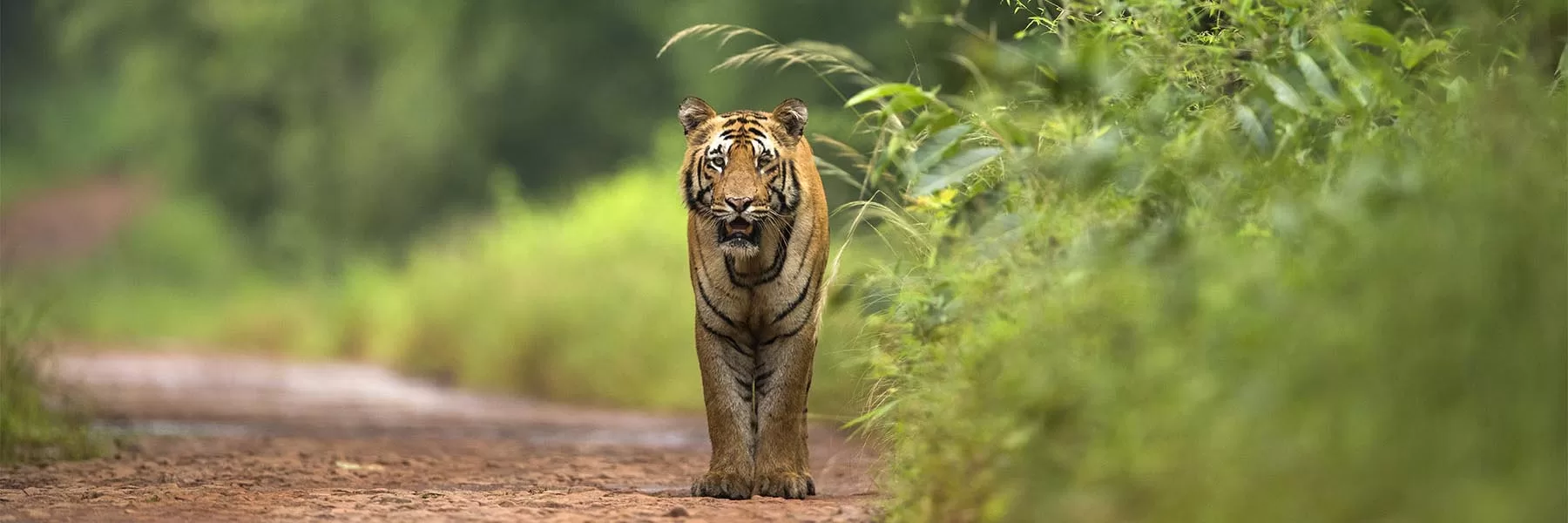India’s diverse flora and fauna create an ideal habitat for tigers. Due to this, the country is home to around 70% of the world’s tiger population These animals belonging to the big cat species are often seen in India’s reserves.
Instead of going to other tiger-range countries like China, Nepal, or Russia, you can easily spot these species during an Indian safari. There are several reserves distributed in Indian states that protect tigers. The most popular include Bandhavgarh, Ranthambore, Jim Corbett, and the Sundarbans Tiger Reserve.

Royal bengal tiger
They attract a large number of tourists from all over the country as well as worldwide. Yet, it means that these reserves and sanctuaries hold most of the crowd. Instead of enjoying tiger sightings in peace, you might need to stand in queues and share safari jeeps with others as well.
If you don’t fancy crowds or would prefer to spot tigers in secluded areas, several reserves in India offer the same. The reason they aren’t visited as much is due to their remote location, which is far from major towns and cities. However, it does not take away from the fact that these underrated reserves offer incredible sightings of tigers.
Here are ten lesser-known tiger reserves in India that should be on your list:
1. Satpura Tiger Reserve, Madhya Pradesh
Satpura National Park and Tiger Reserve is a relatively new wildlife sanctuary in India. Tourists have not yet explored it, and it stands as the least visited park. Nevertheless, a growing population of tigers, which can be seen stalking through the park’s forest, gorges, and ravines, inhabits it.

Satpura Tiger Reserve
The reserve makes for a fantastic destination to experience the off-beaten path. You can explore the national park on foot and observe its unique wilderness. It also has various wildlife species like leopards, porcupines, sloth bears, and flying squirrels.
You can enjoy the activity of kayaking here, which only a few parks offer.
Best time to visit: October–March and April–May
2. Dudhwa Tiger Reserve, Uttarakhand
The Dudhwa tiger reserve comprises Katarniaghat wildlife reserve, Dudhwa National Park, and Kishanpur Wildlife Sanctuary. It also shares the northeastern boundary with Nepal, defined by the Mohana River.

Dudhwa Tiger Reserve
The reserve is home to an estimated 106–118 tigers. Other animals like sambar deer, swamp deer, spotted deer, ratel, jackal, sloth bear, leopard, and more can also be seen. You can also observe 450 species of birds at the reserve.
The national park hosts jeep safaris annually to catch the amazing wildlife in its dense ambiance.
Best time to visit: December–April
3. Manas National Park, Assam
Manas Tiger Reserve is a UNESCO Natural World Heritage Site. It is situated in the foothills of the Himalayas and is surrounded by alluvial grasslands and tropical forests.

The rare capped langur in Manas National Park
Manas represents two separate biomes: the forest biome and the grassland biome. Presently, the total population of tigers recorded is 60. There are 55 species of mammals, 50 species of reptiles, and 380 species of birds. The park has rare and endangered species like the Assam roofed turtle, golden langur, and pygmy hog.
You can experience the beautiful wilderness of Manas National Park by taking a safari ride.
Best time to visit: October-April
4. Nameri National Park, Assam
Nameri national park is located in the hills of the Eastern Himalayas. The park shares its northern boundary with the Pakhui Wildlife Sanctuary, which lies in Arunachal Pradesh. Nameri has dense forests that offer scenic and breathtaking landscapes for visitors.

Nameri National Park
Although tiger sightings are rare, you can still spot the predator once in a blue moon during a guided walk. Nameri National Park proves to be a birdwatcher’s paradise, as it has over 300 species of vibrant birds. You can spot the white winged wood duck, great pied hornbill, rufous necked hornbill, and more.
Aside from tigers, animals such as the Asiatic wild dog, clouded leopard, marbled cat, Himalayan black bear, and others reside in the park’s habitat. Kayaking is one of the most popular activities enjoyed by visitors at Nameri.
Best time to visit: November-April
5. Mudumalai National Park, Tamil Nadu
Mudumalai National Park and Wildlife Sanctuary are located on the north-western side of the Nilgiri Hills. The sanctuary is divided into five ranges – Kargudi, Mudumalai, Nellakota, Masinagudi, and Thepakadu. The park’s protected area is home to vulnerable and endangered species of animals and birds.

Mudumalai Tiger Reserve
Mudumalai was established in the year 1940 and is the second oldest national park in India. Out of the 15 Indian cat species that exist, four are found here. These include the Bengal tiger, jungle cat, leopard cat, and Indian leopard. In addition to this, about 50 species of fish, more than 200 species of birds, and 55 species of mammals are found.
The Mudumalai Sanctuary is an integral wildlife habitat and is part of the Nilgiri Biosphere Reserve.
Best time to visit: February-May
6. BR wildlife sanctuary and tiger reserve, Karnataka
The Biligiri Ranganatha Swamy Temple (BRT) wildlife sanctuary is situated on the Biligirirangana Hills. The sanctuary is considered a wildlife corridor that connects the Eastern and Western Ghats. The hills are covered with diverse species of plants and offer shelter to a variety of wildlife.

A tiger sighted in BR Tiger Reserve
A survey revealed the presence of 62 tigers in the BR tiger reserve. Other than these predators, it is also famous for its herds of wild elephants. For sightseeing, you can also observe small and large mammals and over 200 species of birds at the sanctuary.
Best time to visit: October-May
7. Rajaji National Park, Uttarakhand
Rajaji National Park and Tiger Reserve encompass the Shivalik Hills, near the foothills of the Himalayas. Three wildlife sanctuaries in the area, namely Motichur, Chilla, and Rajaji, were merged to form the Rajaji Tiger Reserve.

Rajaji National Park
Dense jungles, varied topography, and rich biodiversity surround the Park. It is famous for tigers, elephants, leopards, ghoral, deer, and a variety of reptiles. To enjoy an authentic experience of the park, tourists can opt for jungle safaris.
With more than 300 species of birds, birdwatching is also an ideal activity at Rajai National Park.
Best time to visit: November-June
8. Bor Tiger Reserve, Maharashtra
The Bor Tiger Reserve is a wildlife sanctuary located near Hingani, Maharashtra. The reserve is spread over a relatively small area and includes the drainage basin of Bor Dam.

A Bengal tiger at Bor tiger reserve
Aside from Bengal tigers, leopards, bison, deer, wild dogs, and more live in the sanctuary. During safaris, people frequently spot tigers, leading to a consistent increase in the tiger population within this small reserve.
There are over 160 species of birds and 26 species of reptiles in the sanctuary. It is a perfect destination for those who would like to visit a small yet picturesque reserve to save time.
Best time to visit: April–May
9. Mukundara Hills Tiger Reserve, Rajasthan
Mukundara Tiger Reserve also goes by the name of Darrah Wildlife Sanctuary and is located on the eastern banks of the Chambal River. It is spread across four districts: Kota, Bundi, Chittorgarh, and Jhalawar. This reserve was once a hunting ground for the Kings of Kota.

A tigress in Mukundara Hills Tiger Reserve
Dense forests cover the reserve, and various kinds of medicinal plants are growing within it. It is also rich in wildlife, and you can spot a few tigers during the safari. You can also see leopards, hyenas, wolves, chinkaras, and antelopes.
For birdwatchers, there are a wide variety of bird species to observe in the reserve.
Best time to Visit: October–June
10. Bhadra Tiger Reserve and wildlife sanctuary, Karnataka
The Bhadra Wildlife Sanctuary and Tiger Reserve are situated along the Western Ghats in the Karnataka district.

Indian tiger at Bhadra Wildlife Sanctuary
Approximately 40 tigers are presently living in the reserve. In addition to these species, one can spot elephants, bison, flying squirrels, and wild boar. It has over 120 species of flora and around 200 different types of birds. The Jangara Giant, a teak tree believed to be around 400 years old, stands as one of the most prominent features of the park.
Best time to visit: October–March
If you would like to visit secluded reserves or simply take your time to explore them, these underrated tiger reserves in India are refreshing and incredible.
If you loved reading this story, then subscribe to our blog here (it will ask to verify your email) to get inspiring travel stories and trivia delivered to your email. Stories about wildlife trivia, cultural experiences, curated luxury hotel lists, underrated places to travel, polar journeys and much more.











